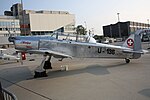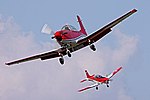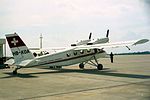Talk:Pilatus Aircraft
| This is the talk page for discussing improvements to the Pilatus Aircraft article. This is not a forum for general discussion of the article's subject. |
Article policies
|
| Find sources: Google (books · news · scholar · free images · WP refs) · FENS · JSTOR · TWL |
| This article is written in British English, which has its own spelling conventions (colour, travelled, centre, defence, artefact, analyse) and some terms that are used in it may be different or absent from other varieties of English. According to the relevant style guide, this should not be changed without broad consensus. |
| This article is rated C-class on Wikipedia's content assessment scale. It is of interest to the following WikiProjects: | |||||||||||||||||||||||||||||||||||||||||||||||
| |||||||||||||||||||||||||||||||||||||||||||||||
Comments
[edit]i flow yours pc 6 in mexican air force, is the only one aircraft in this army force in mexico what never had a one accident. mexican air force have 4 pc 6 and plus more less 15,000 horus total for this aircraft. tanke your for make this tipe aircraft, my instructor was mr. coles. congratulations and good landing in yours fly.
Comments 2
[edit]Was this page written by Pilotus marketing people? —Preceding unsigned comment added by 217.42.215.178 (talk) 21:43, 23 March 2009 (UTC)
Proposed additions
[edit]Unfortunatly my english is not very well so i hope someone can put in this informations on correct english.
All this informations are on the german version of wikipedia, also the are ot of the book Book Pilatus Flugzeuge 1939 – 1989 von Roland Eichenberger please notice that the (english ) link to the pdf magazin, holds more informations , than the one to the homepage of pilatus.Especali about the licence building of parts of helicopter&fighterjets.
German wikipedia http://de.wiki.x.io/wiki/Pilatus_P-1 http://de.wiki.x.io/wiki/Pilatus_P-5 http://de.wiki.x.io/wiki/Pilatus_PC-8D http://de.wiki.x.io/wiki/Pilatus_PC-10 http://de.wiki.x.io/wiki/Pilatus_PC-24 http://de.wiki.x.io/wiki/Pilatus_Aircraft
Pilatus put forth as a subcontractor of RUAG Aerospace parts (Outer Wings) for the Swiss F/A-18. Even before Pilatus was in all licensed production of jets (eg. de Havilland Vampire and helicopters(eg. Alouette III for the Swiss Air Force involved as suppliers, and also as subconstructer for the all swiss FFA P-16 production (which was however Cancelled. Pilatus as subcontractors of RUAG manufactures parts for Airbus and Boeing, and also performs on behalf of RUAG maintenance work on aircraft such as Eurocopter AS332 Super Puma. — Preceding unsigned comment added by 193.5.216.100 (talk)
Important Facts about the History of Pilatus
[edit]Important parts like projects are allways delete out of this page bye some stupid persons: Stop deleting important facts out of Pilatus! This are Important facts in the history of pilatus. the reference ist given its out from the book in the referenclist, it does no mather that this book is only aviable in german. It fits wit the wikipedia rouls and with the US rouls and most important wit the swiss rouls (because the book is from switzerland). Because all this are projects they have to be on the main page of pilatus (only for the P-8D who was build in a single prototype probaly a own page can be made). — Preceding unsigned comment added by 193.5.216.100 (talk)
- Unfortunately, the material you have been adding is unsuitable for a manufacturer's article, as has been explained in the edit summaries each time the info has been removed. It is far too long, and poorly written. As this marterial is a translation, I'm not able to rewrite it myself without direct access to English language sources. Perhaps someone who is fluent in both English and German can wrte a brief summary on the project types, but specs and long histories on individual designs are not approriate for a manufacturer's article, or for a talk page. Also, please note that comments such as "stupid persons" are not approriate on English WP Talk pages, and further such comments could lead to your being blocked from further editing. - BilCat (talk) 17:58, 3 January 2013 (UTC)
Missing Types
[edit]Whats about Pilatus P-1, P-5, why are not more Informations about the PC-8? I checked out the orginal page in german there are more informations about them. Someone should add this, but I can't edit the page,its not possible. Such incomplet pages are not very usefull. — Preceding unsigned comment added by 158.181.96.121 (talk) 17:57, 9 January 2013 (UTC)
Edit request on 9 January 2013
[edit]This edit request has been answered. Set the |answered= or |ans= parameter to no to reactivate your request. |
85.1.75.33 (talk) 19:18, 9 January 2013 (UTC)
- I presume this request relates to the comment above about missing types, I have added the unbuilt P-1 and P-5 to the list of aircraft. They could be mentioned in the main "history" section but as that section really needs to be re-written in a more encyclopedic format. It is a history of the company and not meant to be a type-by-type chronology. MilborneOne (talk) 19:52, 9 January 2013 (UTC)
- I have tweaked the history bit to include the "missing" aircraft using the Pilatus Chronicle as a source. MilborneOne (talk) 20:57, 9 January 2013 (UTC)
Thank you very much MilborneOne for your work. I would recomen to create a sub page of Pilatus about all the unbuild aircrafts P-1,P-5, PC-10 and PC-24 (as soon as the PC-24 became a real Aircraft it could be deeletet from this page and get its one).
Looking at the SB-2 Pelican with his one page I think the PC-8D should have its one page too, because it was like the SB-2 a real aircraft who realy get airborne and flow a few times. I think it is placed on the wrong place at the PC-6 Page, of corse it is based on the PC-6 but it has its one name, a differend bow, tail, wings and 2 engines..(its a bigger different Type of aircraft PC-6 vers PC-8 like A330 to A340). — Preceding unsigned comment added by 82.136.69.160 (talk) 13:20, 11 January 2013 (UTC)
- I have created Pilatus PC-8D Twin Porter, the other flown aircraft should get a page eventually. Normally we dont create articles on unflown aircraft and would describe them in an article like List of Pilatus aircraft (see List of de Havilland aircraft as an example). If nobody else gets around to it I will look to se if I can create something soon. MilborneOne (talk) 15:15, 11 January 2013 (UTC)
Pilatus Projects.
[edit]It would be great if someone could create a sub page of pilatus with all the Projects.
Here all dates, they are from the book Eichenberger, Roland. Pilatus Flugzeuge: 1939–1989. Stans: Pilatus Flugzeugwerk, 1989
P-1
[edit]The Pilatus P-1 was a single-engine plane from the aircraft manufacturer Pilatus Aircraft, but never reached the mass production. Unfortunately, hardly any documentation on the Pilatus P-1 are present. The project began around the end of October 1940. It was the first project of Pilate and the structural design has greatly on the manuscript by engineer Henri Fiert, and some basic principles for the subsequent P-2 are unmistakable. Respectively the Pilatus P-1 abolished the basis for the development of the Pilatus P-2. It remained only for the project and no prototype was built.
Structure
Single-seat training aircraft. Fuselage of welded steel tube, with removable front panels, rear fabric covered. Wings: wooden structure with a continuous beam, plywood planking.
Specifications
- An air-cooled inline engine Argus As 10E2 with an output of 240hp (180 kW)
- Wingspan 9.20 m
- Length 6.90 m
- Height 2.10 m
- Wing area 12.70 sq.m.
- Net weight 850Kg
- Start Weight 1150kg
- Top speed of 600m / m 325km / h
- Rate of climb of 600m / m 6.5 m / sec
- High altitude 6000m
P-5
[edit]The Pilatus P-5 would have been a single-engine aircraft from the manufacturer Pilatus Aircraft, but this idea never got beyond the planning stage.
The first drawings for the Pilatus P-5 were made in1951. The client was the Federal Military Department (EMD). The main purpose for the P-5 was for artillery observation. It was a single-engine, two-seat high-wing monoplane with fixed wheels. The aircraft frame was intended to be built out of tubular steel and skinned with metal. The main wings and tail were intended to be made from an alloy, not steel. This aircraft had fixed wing with slats and flaps fitted on to them. The pilot and observer were seated in a generously glazed cabin that had exceptionally good visibility in all directions. This view was due mainly to the curved sides which allowed the aircrew to look almost straight down. This P-5 design was abandoned in 1951 and no prototype aircraft were ever built.
Specifications
- An air-cooled six-cylinder in-line engine Walter Minor 6-III with an output of 160 hp
- Wingspan 12.00 m
- Length 9.20 m
- Height 2.50 m
- Normal flight Weight 860 kg
- Top speed 190 km / h
- Landing speed 53 km / h
- Climb 6 m / sec
- Service ceiling 4800 m
- Take off distance 65 m
- Landing distance 50 m
PC-10
[edit]The Pilatus PC-10 was the common name of different designs for a twin-engine aircraft manufacturer Pilatus Aircraft, but none of them reached the production stage.
Turbopropversion PC-8D / PC-10 Twin Porter
[edit]The first draft was basically an unchanged Pilatus PC-8D, the place of the piston engines | would have been equipped with turboprop.
PC-10 Mini Twin
[edit]Under the name PC-10 MiniTwin a machine was designed for 11 people, on the left rear side of the hull with a cargo door with integrated passenger door. The aircraft had. A projected total length of 11.44 m and a height of 4.75 m with a span of 16 m
Twin Project PC-10
[edit]Under the name Twin Project PC-10 is a slightly larger plane was designed which possessed on the left rear fuselage just a passenger sliding door that opens to the rear. For it in the rear fuselage a loading door was built. The aircraft would have a total length of 13.50 m, a height of 6.08 meters and a wingspan of 19 meters.The machine should be able to transport 16 people, or nearly 2 tons of cargo. It had been equipped with a fixed landing gear and two Garrett TPE-331 or Pratt & Whitney PT6A-27 turboprop engines. Externally, the latter two designs regarding chassis, wings and engine assembly resembled strongly the DHC-6 Twin Otter, but the tailplane difference to an enlarged version of the Pilatus PC-6 and Pilatus PC -8 Twin Porter used that has no sweep. The project was not pursued.
PC-24
[edit]The Pilatus PC-24 is a project of the aircraft manufacturer Pilatus Aircraft, for a 2-engine business jet. The CEO of Pilatus Oscar Schwenk announced on April 17, 2011 that Pilatus in the fall of 2012 or early 2013, will present the detailed design of the PC-24. The delivery of the PC-24 is planned for 2015. The PC-24 is mainly made of composite materials, and plastics of existing business jet that is driven by two jet engines. It is the first commercial jetliner of Pilatus.
- Pilatus types youtube [1] — Preceding unsigned comment added by 85.1.75.33 (talk) 10:10, 21 February 2013 (UTC)
Canton
[edit]Hi.
Stans is in Nidwalden, not Obwalden.
- -)
Stefan — Preceding unsigned comment added by 86.160.217.56 (talk) 22:04, 24 January 2013 (UTC)
- That's true, and so is Buochs. I fixed this, thanks. Gestumblindi (talk) 01:29, 25 January 2013 (UTC)
Proposal of an gallery of types
[edit]My Idea is to put on ONE picture of each type who was build by Pilatus (and at least a picture exist) on the Main Page of Pilatus Aircraft so that a reader has a visual overwive about it can see the differend types without clicking at each subpage or go to commons and search ther for every type. This was the reasn why I had done this. Just listing up the types looks a bit "steril" to me.
FFA P-16 (talk) 19:34, 5 August 2014 (UTC)
- I dont agree that a gallery is needed as we have a link to images at commons, perhaps a table format with small images may be better. MilborneOne (talk) 19:48, 5 August 2014 (UTC)
| Name | Description | |
|---|---|---|

|
Pilatus SB-2 | 1944 STOL Transporter only 1 aircraft |
| Pilatus P-1 | 1941 single-seat trainer Project only | |

|
Pilatus P-2 | 1942 Trainer |

|
Pilatus P-3 | 1953 Trainer |
| Pilatus P-4 | 1948 STOL Transporter 1Prototyp only | |
| Pilatus P-5 | 1951 artillery observation aircraft Project only | |

|
Pilatus PC-6 | 1959 STOL Transporter |

|
Pilatus PC-7 | 1966 Turboprop trainer |

|
Pilatus PC-8D | 1967 STOL Transporter only 1 Prototyp |

|
Pilatus PC-9 | 1984 Turboprop trainer |
| Pilatus PC-10 | 1970 twin-engined Transporter Project only | |

|
Pilatus PC-11 | 1972 Glider aircraft |

|
Pilatus PC-12 | 1991 Single-engined transport/biz Turboprop |

|
Pilatus PC-21 | 2001 Turboprop trainer |

|
Pilatus PC-24 | 2014 Twin-engined transport/biz jet |
Pilatus aircraft in aerobatic teams
[edit]To delet this out just because other aircraft Manufacturers articels have not (yet) such a list is not a reason. Somebody who comes along this page about Pilatus is might interested, and as it is a collapsing list it does not disturb readers who are not interested in this informations. FFA P-16 (talk) 00:39, 11 January 2016 (UTC)
| Aerobatic team | Country | Typ | Remark |
|---|---|---|---|
| P-3 Flyers | P-3 | civilian team | |
| Patrouille Suisse | PC-6 | Only Support / Transport PC-6T V-622 "Felix" | |
| PC-7 Team | PC-7 | ||
| Silver Falcons | PC-7 | ||
| Alap-Alap Formation | PC-7 | ||
| Taming Sari | PC-7 | ||
| Solo Display Team | PC-7 | as well as a F-16 and an AH-64 | |
| Blue Phoenix | PC-9 | ||
| Wings of Storm | PC-9 | ||
| Roulettes | PC-9 | ||
| Swiss Air Force PC-21 Demo |
PC-21 | will be presented only sporadically to not to compete Pilatus Aircraft | |
| Pilatus Aircraft | PC-21 | civil, Demonstration with 1 or 2 aircraft |
- This is an article about a company. The information is not relevant to the company, just as information listing B-25 Mitchells used for air displays would be irrelevant in the North American Aviation article, or listing radios used in ambulances would be irrelevant in the Motorola article. YSSYguy (talk) 01:07, 11 January 2016 (UTC)
O.K. I understand, but I think a link to the team is for some readers interesting.FFA P-16 (talk) 01:43, 11 January 2016 (UTC)
- Aircraft are used in too many different roles to start listing the individual roles and users of each type on the manufacturers' articles. And display teams are a relatively minor use. - BilCat (talk) 08:13, 11 January 2016 (UTC)
- I agree that this should not be included. It isn't germane to the manufacturer, which is the subject of the article and looks far too promotional. - Ahunt (talk) 19:05, 11 January 2016 (UTC)
External links modified (January 2018)
[edit]Hello fellow Wikipedians,
I have just modified one external link on Pilatus Aircraft. Please take a moment to review my edit. If you have any questions, or need the bot to ignore the links, or the page altogether, please visit this simple FaQ for additional information. I made the following changes:
- Added archive https://web.archive.org/web/20160819031606/http://www.pilatus-aircraft.com/00-def/main/scripts/ckfinder/userfiles/files/Downloads/Brochures/Pilatus-Aircraft-Ltd-Chronik-EN.pdf to http://www.pilatus-aircraft.com/00-def/main/scripts/ckfinder/userfiles/files/Downloads/Brochures/Pilatus-Aircraft-Ltd-Chronik-EN.pdf
When you have finished reviewing my changes, you may follow the instructions on the template below to fix any issues with the URLs.
This message was posted before February 2018. After February 2018, "External links modified" talk page sections are no longer generated or monitored by InternetArchiveBot. No special action is required regarding these talk page notices, other than regular verification using the archive tool instructions below. Editors have permission to delete these "External links modified" talk page sections if they want to de-clutter talk pages, but see the RfC before doing mass systematic removals. This message is updated dynamically through the template {{source check}} (last update: 5 June 2024).
- If you have discovered URLs which were erroneously considered dead by the bot, you can report them with this tool.
- If you found an error with any archives or the URLs themselves, you can fix them with this tool.
Cheers.—InternetArchiveBot (Report bug) 19:22, 22 January 2018 (UTC)
Abreviation for Swiss curency
[edit]The Swiss francs has never been abrebviatet as "Swfr". There are official rhules for denomination of currencys, and so the Swiss Franc is called CHF (CH from the official universal naming for Switzerland Confoederatio Helvetica). --Cosy-ch (talk) 12:18, 21 May 2018 (UTC)
- According to Swiss franc CHF is the ISO 4217 code, but FR. or SFr. is the Currency symbol. Given the confusion I think this is best fixed by spelling it out. - Ahunt (talk)
- Wikipedia articles that use British English
- C-Class company articles
- Low-importance company articles
- WikiProject Companies articles
- C-Class aviation articles
- C-Class aircraft articles
- WikiProject Aircraft articles
- WikiProject Aviation articles
- C-Class Switzerland articles
- Low-importance Switzerland articles
- All WikiProject Switzerland pages





